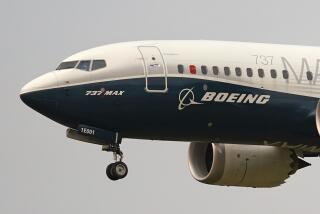Why Orders for New Airliners Are Taking Off
- Share via
NEW YORK — The major airlines’ ever-larger aircraft purchases--topped by United Airlines’ $22 billion deal this week with Boeing Co.--reflect a common strategy:
To compete both at home and abroad, the carriers are building fleets which are bigger, quieter, more fuel efficient and otherwise cheaper to maintain and operate.
And despite the mind-boggling scale of the purchases, analysts say they are undertaken at little risk. If it turns out that an airline doesn’t need a plane it has ordered, it can expect to sell its slot on the production line at a profit.
“If you want to grow, you’ve got to do it with new aircraft,” said John Mattis, an airline analyst with Shearson Lehman Brothers.
The United purchase underscores the point. The Chicago-based carrier’s fleet consists largely of dated 727s, DC-10s, 747-100s and 737s. Many of the planes, dating from the first generations of jets and widebodies, are nearing the end of their useful lives.
“They are expensive to operate,” Mattis said. “You can extend their life, but that is expensive, requiring a lot of maintenance. And the older planes have noise and fuel problems.”
So United and many of its competitors--for instance, Continental Airlines, which recently placed a firm order for 25 Boeing 757s and took an option on 25 more--are on a buying binge.
Orders for new aircraft by American carriers and options for additional planes total $165 billion, according to Lee R. Howard, chief executive officer of Airline Economics Inc., a Washington consulting firm. By the estimate of Avmark Inc., an Arlington, Va., consultant, firm orders total $53.4 billion.
With jet fuel prices soaring as the Persian Gulf stalemate wears on, the improved fuel economy of the newest jets has helped focus the carriers’ attention on the urgent need to update their fleets.
“Even though capital costs (of new airplanes) are significant, at $1.20 per gallon fuel cost--with some prices going as high as $1.40--the savings are significant as well,” said Hans J. Plickert, an analyst with the Transportation Group, an affiliate of Paine Webber Inc.
Observers note that most of the new jets--including the 757--have only two engines, and those engines are more fuel efficient than their predecessors. The result is fuel economy savings of 25% compared to such jets as the 727, which they are designed to replace.
The new planes help airlines reduce labor costs too because they carry cockpit crews of two versus the three-person crews required by some older planes.
And they can carry more passengers. The 757, for example, has 25 more seats than the 727. That helps reduce the need to add flights and the competition for gates at airports--an ever more pressing concern.
“The world is running out of airport space,” noted Plickert.
United and other U.S. carriers that fly overseas need new airplanes to beat back challenges from foreign competitors, adds Paul Turk, an analyst with Avmark.
Though it is the dominant carrier in the Pacific, United still loses business due to its antiquated fleet. Its 747-SP’s and 747-200s require a crew of three, which makes scheduling difficult and adds greatly to wage costs. Planes frequently have to fly with empty seats so that they can carry enough fuel to get across the ocean.
United’s flights also have to make stops, while its foreign competitors--including Japan Air Lines and Singapore Airlines--are able to offer nonstop service.
On trans-Atlantic routes too, European carriers in many cases have newer planes than their American competitors.
The consequences are clear.
“If your older planes require more folks to drive them, more fuel to fly them and more wrenches to fix them,” said Turk, “you’re going to have trouble making money.”
Turk further noted that the European nations are becoming very tough on noise requirements. About half of the U.S. carriers’ planes, he said, cannot meet European standards.
Though the airlines’ big purchases may begin to look ill-advised if business falls off, the carriers are not expected to cancel any orders, observers say.
For one thing, any downturn is expected to be temporary. And besides, airlines take no risk by ordering planes.
Back in January, 1989, Braniff Airways--which has since gone bankrupt--paid Pan American World Airways $110 million for 16 slots on Airbus Industrie’s A 320 production line.
Since Airbus returned Pan Am’s deposit, the payment from Braniff was pure profit.
More to Read
Inside the business of entertainment
The Wide Shot brings you news, analysis and insights on everything from streaming wars to production — and what it all means for the future.
You may occasionally receive promotional content from the Los Angeles Times.










